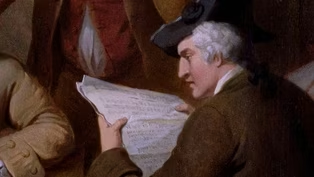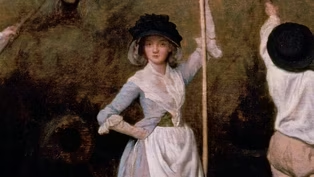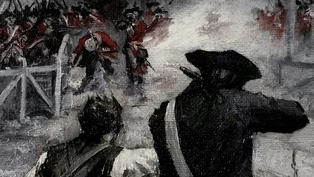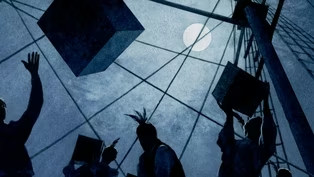
The Boston Massacre
Clip: Episode 1 | 7m 52sVideo has Closed Captions
A bloody clash between Bostonians and the British army leaves five dead in the Boston Massacre.
On October 1st, 1768, General Gage and the British Army arrive in Boston to begin their occupation. Tensions continue to rise between Bostonians and the British until it erupts on March 5th, 1770 as British grenadiers respond to a quickly forming mob and fire into the crowd, leaving 5 dead. Although most of the soldiers are later exonerated, the event will come to be known as the Boston Massacre.
Problems playing video? | Closed Captioning Feedback
Problems playing video? | Closed Captioning Feedback
Episodes presented in 4K UHD on supported devices. Corporate funding for THE AMERICAN REVOLUTION was provided by Bank of America. Major funding was provided by The Better Angels Society and...

The Boston Massacre
Clip: Episode 1 | 7m 52sVideo has Closed Captions
On October 1st, 1768, General Gage and the British Army arrive in Boston to begin their occupation. Tensions continue to rise between Bostonians and the British until it erupts on March 5th, 1770 as British grenadiers respond to a quickly forming mob and fire into the crowd, leaving 5 dead. Although most of the soldiers are later exonerated, the event will come to be known as the Boston Massacre.
Problems playing video? | Closed Captioning Feedback
How to Watch The American Revolution
The American Revolution is available to stream on pbs.org and the free PBS App, available on iPhone, Apple TV, Android TV, Android smartphones, Amazon Fire TV, Amazon Fire Tablet, Roku, Samsung Smart TV, and Vizio.
Providing Support for PBS.org
Learn Moreabout PBS online sponsorship[Drum beating rhythmically] Voice: I was born in Boston in America in the year 1760.
In the time I was at school, the troubles began to come on.
And I was told the day of judgment was near at hand, and the moon would turn into blood, and the world would be set on fire.
John Greenwood.
Narrator: Shortly before noon on Saturday, October 1, 1768, 8-year-old John Greenwood left his home in Boston's North End and hurried toward the waterfront.
There, riding at anchor in a great arc, he saw 14 British warships, their cannon trained upon the city.
Boats swarmed between the ships and the end of Long Wharf, ferrying hundreds of British red-coated regulars.
General Gage's occupying army had arrived.
The crowds that lined the street were for the most part silent and sullen.
But it was not the history being made that impressed young John Greenwood that day.
It was the irresistible music played by Afro-Caribbean men and boys in colorful uniforms.
Voice: I was so fond of hearing the fife and drum played by the British that somehow or another, I got an old split fife, and fixed it by puttying up the crack to make it sound, and then learned to play several tunes.
I believe it was the sole cause of all my travails and disasters.
[Greenwood] [Fife playing upbeat tune] Narrator: Before long, the boy was playing well enough to become a fifer for a local militia.
"The flag of our company," he remembered, "was an English flag."
They would not be English forever.
Half the newly arrived troops were housed in barracks on Castle Island, but orders from London had been clear.
It was "His Majesty's pleasure," they said, that the rest of the troops "be quartered in that town."
[Man shouting orders] For 17 months, Boston was an occupied city.
The rattle of drums awakened residents every morning.
Passersby were routinely stopped and searched.
Many soldiers had brought their wives and children; others courted Boston girls, or were pursued by them.
40 troops were married during the occupation, and more than 100 of their offspring were baptized.
But some soldiers got drunk, robbed people, insulted women, profaned the Sabbath.
There were brawls, stabbings, suits and countersuits.
From London, Benjamin Franklin was concerned.
Voice: Some indiscretion on the part of Boston's warmer people, or of the soldiery, may occasion a tumult.
And if blood is once drawn, there is no foreseeing how far the mischief may spread.
[Franklin] Narrator: On the evening of March 5, 1770, there were tussles between Bostonians and British soldiers all across the city.
At the Royal Customs House, a crowd of young men surrounded a lone sentry and pelted him with snowballs and chunks of ice.
Convinced a city-wide uprising was underway, Captain Thomas Preston raced several armed grenadiers to the scene.
More snowballs and rocks and oyster shells greeted them.
They fixed bayonets.
[Bells tolling] Zabin: Somebody starts ringing the church bells, which in Boston is a sign for fire.
Some people are bringing buckets to be part of a bucket brigade.
Some people are drawn by the noise.
It's very hard, in fact impossible, to know what happened, which is that somebody yells, "Fire."
[Gunfire] All we know really is that when the smoke cleared, there are 5 people dead or dying.
Narrator: The first was a tall dock-worker-- part Native-American, part African-American-- named Crispus Attucks.
The second was a ropemaker named Samuel Gray, who was standing next to Attucks.
The third was James Caldwell, a sailor who was in town, it was said, to call upon the girl he hoped to marry.
The terrified crowd began to scatter.
John Greenwood's older brother Isaac was there, too, and escaped unharmed, but a ricocheting ball hit their friend Samuel Maverick in the back.
He died in agony the following morning.
Maverick, an apprentice, had shared a bed in the Greenwood home with the now 9-year-old John, who recalled that after his friend's death, he deliberately slept in pitch-black darkness, hoping "to see his spirit."
Zabin: People start arguing, already, even before they go to bed, about what happened.
Paul Revere creates probably the most famous engraving of the 18th century, which he titles the "Bloody Massacre."
The British Army is very anxious to try to spin this as a story of self-defense... but the language of massacre is the one that holds.
Narrator: A fifth man, a leathermaker named Patrick Carr, would die several days later.
10,000 mourners accompanied the coffins of the dead to the Old Granary Cemetery.
Voice: The Fatal Fifth of March can never be forgotten.
The horrors of that dreadful night are but too deeply impressed on our hearts-- when our streets were stained with the blood of our brethren; and our eyes were tormented with the sight of the mangled bodies of the dead.
Joseph Warren.
Narrator: Not everyone was grieving.
An Anglican clergyman, Mather Byles, asked a fellow cleric, "Which is better, "to be ruled by one tyrant 3,000 miles away or by 3,000 tyrants not a mile away."
[Gavel banging rapidly] Captain Preston was found not guilty of ordering his men to fire.
The other 8 soldiers were put on trial separately.
Samuel Adams' younger cousin, John Adams, risking his reputation, served as the soldiers' attorney.
Most of his clients were acquitted as well.
Two were found guilty of manslaughter.
They were branded on their right thumbs so that if they were ever charged with another crime, they could not make a claim of innocence again.
The British government was relieved by the outcome of the trials.
Most of the regulars were withdrawn to Castle William-- their harbor fortress.
Once again, American colonists had forced the British to back down and Parliament had already repealed all but one of the Townshend Acts.
Only the duty on tea remained.
Video has Closed Captions
Clip: Ep1 | 9m 39s | The American Revolution will be a war that will pit brother against brother – and birth a nation. (9m 39s)
How Land, Taxes and Rebellion Sparked the American Revolution
Video has Closed Captions
Clip: Ep1 | 7m 28s | The Stamp Act and taxes on American colonists lead to unrest and threaten to cause a revolution. (7m 28s)
How the Townshend Acts Fueled a Resistance Movement
Video has Closed Captions
Clip: Ep1 | 3m 11s | When the British imposed new taxes, women joined the Resistance Movement by the thousands. (3m 11s)
Liberty for Whom? Slavery, Protest and the Ideals of the Revolution
Video has Closed Captions
Clip: Ep1 | 7m 33s | The revolutionary ideals of liberty spread across the colonies while many suffer from enslavement. (7m 33s)
Rising Tensions Didn't Keep European Settlers from Coming to North America
Video has Closed Captions
Clip: Ep1 | 2m 56s | Thousands poured down the Great Wagon Road, eager to start a new life in North America’s interior. (2m 56s)
The Shot Heard ’Round the World: Lexington, Concord and the Start of War
Video has Closed Captions
Clip: Ep1 | 11m 39s | Tensions erupt as colonists confront the British Army at Lexington and Concord, beginning the war. (11m 39s)
Tea, Tar and Tyranny: How the Boston Tea Party Changed Everything
Video has Closed Captions
Clip: Ep1 | 9m 26s | Bostonians protest the newly passed Tea Act by dumping 46 tons of tea into the Boston Harbor. (9m 26s)
Providing Support for PBS.org
Learn Moreabout PBS online sponsorshipSupport for PBS provided by:
Episodes presented in 4K UHD on supported devices. Corporate funding for THE AMERICAN REVOLUTION was provided by Bank of America. Major funding was provided by The Better Angels Society and...























